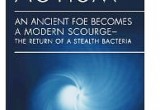New Book on Autism Stirs Interest
A new book entitled Autism: An Ancient Foe Becomes a Modern Scourge -the return of a stealth bacteria, by Lawrence Broxmeyer, M.D. makes a well-documented case for the fact that a stealth pathogen, eluding today's diagnostics , is behind autism.
Online, November 28, 2012 (Newswire.com) - The consensus that autism is from an intrauterine infection is growing, bolstered by Patterson's and Fatemi's studies. However, the question still unanswered remains: which infection? This of course is unknown. But in Autism: An Ancient Foe, a prime, conceivable candidate is logically presented, and compellingly supported by scientific literature, old and new. The book is available on Amazon.com.
Until 1980 autism is called "childhood schizophrenia" and in some parts of the world, it still is. By the same token, an extensive body of medical literature ties schizophrenia to mycobacterial disease, the infectious focus of this book. This was only brought more sharply into focus when Rzhetsky, in 2007, used a proof-of-concept biostatistical analysis of 1.5 million patient records, to find significant genetic overlap in humans with autism, schizophrenia........and tuberculosis. To this effect NIMH trials, presently ongoing, will determine whether the anti-tubercular drug Seromycin helps to diminish the symptomatology of autism as it did in animal models.
In a sense, this connection is hardly a new one. As early as the 1887s, John Langdon Down, a subset of whose "developmentally disabled" children were autistic, saw this infection "for the most part" as resulting from parental tuberculosis.
Ann Arbor pathologist A.S. Warthin, appearing in The Journal of Infectious Diseases, suggested that even a woman with silent foci of tuberculosis in her body, and with no symptoms could experience reactivation of her disease upon becoming pregnant. That, in turn, could transmit blood-borne TB bacilli to her unborn child. In fact, Warthin emphasized, this sort of transmission was not only possible, but common. Warthin saw silent asymptomatic tuberculosis during pregnancy as a "very grave danger" to the fetus. He also mentions that tubercle bacilli could pass through the placenta into fetal circulation without causing changes to either placental structure, or actual fetal tissue. In such cases, it could only be found in fetal blood-where it could remain, undetected, while -as J.F. Schoeman would later argue -it could cause the sort of neonatal brain lesions that lay behind all neurodevelopmental disorders, including autism.
But TB has been "eradicated," right? Hardly, Broxmeyer explains. While tuberculosis is not generally regarded in the West as the killer disease it once was, according to the World Health Organization, TB presently affects over one-third of the world's inhabitants. Even in the twenty-first century, globally, at least one person is infected with tuberculosis per second, and someone dies of TB every ten seconds. Tuberculosis kills 2-3 million people each year, more than any other infectious disease in the world.
Eight years in the making, AUTISM: An Ancient Foe Becomes a Modern Scourge is a short and fascinating read that is equal parts science, history, and whodunit. Broxmeyer's meticulously-documented biography of the disease weaves back and forth in time and place like a Ken Burns film edited by Tarantino. Readers leap from the modern day back to the 1800s, forward to the 1930s, and then back again as Broxmeyer spins his tale and makes his case. Along the way, he explores the little-known historic connection between autism, schizophrenia, and tuberculosis, and explains in layman's terms the complex series of steps, missteps, and steps-left-untaken that have allowed autism's "stealth pathogen" to evade modern diagnostics for decades.
The book is presently available on Amazon at http://www.amazon.com/AUTISM-Ancient-Becomes-Scourge-bacteria/dp/1478101261/ref=sr_1_1?ie=UTF8&qid=1354109688&sr=8-1&keywords=Autism%3A+An+ancient+foe
